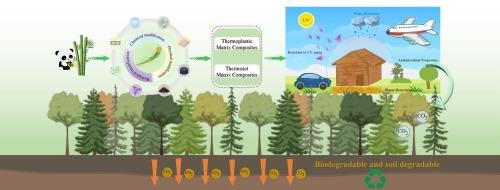综述了竹基复合材料的多功能研究进展及可持续发展趋势
IF 9.2
2区 工程技术
Q1 ENERGY & FUELS
引用次数: 0
摘要
为应对石油基材料资源的稀缺和日益严重的环境问题,开发环保型复合材料迫在眉睫。使用天然纤维增强聚合物来制造复合材料是一项最先进的技术,不仅可以显着减少碳足迹,而且可以满足轻质和高强度结构材料的要求。竹子作为天然纤维的杰出代表,具有成熟期短、生产成本低、可生物降解、力学性能优异等特点。本文综述了纤维含量、纤维尺寸、纤维表面改性、纳米材料和功能物质的添加对竹纤维增强聚合物的力学、热性能、阻燃性能、耐久性、吸水性、生物降解性和可回收性的影响。在对复合材料基体进行分类的基础上,从热塑性和热固性两方面对竹基复合材料体系进行了讨论。本文还介绍了这两种竹基复合材料的不同应用,并对其潜在的应用和前景进行了展望,这可能对竹材等农林业废弃物的有效回收至关重要。本文为竹基复合材料领域的研究人员和专家提供了重要的见解和建议,可以为材料的可持续发展提供思路。本研究也为生物质及生物质衍生材料的应用生产高附加值绿色复合材料提供了参考。本文章由计算机程序翻译,如有差异,请以英文原文为准。

An overview of the multifunctional research progress and sustainable development trends in bamboo-based composites
To cope with the scarcity of petroleum-based material resources and increasing environmental problems, the development of environmentally friendly composite materials is imminent. The use of natural fibers to reinforce polymers to create composites is a state-of-the-art technology that not only significantly reduces the carbon footprint but also meets the requirements for lightweight and high-strength structural materials. As an outstanding representative of natural fibers, bamboo has a short maturity period, low production costs, biodegradability, and excellent mechanical properties. This paper reviews the effects of fiber content, fiber size, fiber surface modification, and the addition of nanomaterials and functional substances on the mechanical, thermal, flame-retardant, durability, water absorption, biodegradability, and recyclability properties of bamboo fiber-reinforced polymers. Based on the classification of composite matrices, bamboo-based composite systems are discussed in this paper in two categories: thermoplastic and thermosetting. This review also describes the diverse applications of the two bamboo-based composites and provides insights into their potential applications and prospects, which may be crucial for the efficient recycling of agroforestry waste, such as bamboo. This paper provides important insights and recommendations for researchers and experts in the field of bamboo matrix composites that can provide ideas for sustainable material development. This study also provides a reference for the application of biomass and biomass-derived materials to produce high value-added green composites.
求助全文
通过发布文献求助,成功后即可免费获取论文全文。
去求助
来源期刊

Sustainable Materials and Technologies
Energy-Renewable Energy, Sustainability and the Environment
CiteScore
13.40
自引率
4.20%
发文量
158
审稿时长
45 days
期刊介绍:
Sustainable Materials and Technologies (SM&T), an international, cross-disciplinary, fully open access journal published by Elsevier, focuses on original full-length research articles and reviews. It covers applied or fundamental science of nano-, micro-, meso-, and macro-scale aspects of materials and technologies for sustainable development. SM&T gives special attention to contributions that bridge the knowledge gap between materials and system designs.
 求助内容:
求助内容: 应助结果提醒方式:
应助结果提醒方式:


